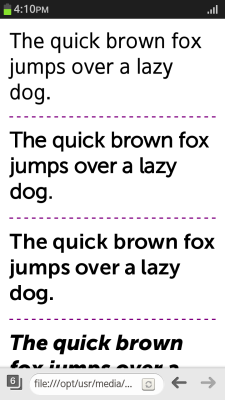WOFF File Format 1.0: Changing Fonts Using WOFF
This tutorial demonstrates how you can modify fonts with WOFF.
Warm-up
Become familiar with the WOFF File Format 1.0 API basics by learning about:
-
Using the WOFF File Format
Change fonts using the WOFF (Web Open Font Format) packaging format.
Using the WOFF File Format
To enhance the user experience of your application, you must learn to use the WOFF (Web Open Font Format) file format 1.0, which is a W3C standard font packaging format used in Web pages:
- Download and use fonts installed on the Web server by creating @font-face rules. Within the rules, you can define the following properties:
-
font-family
Defines a name for the font. This property is mandatory.
-
src
Defines the URL of the font file on the server. This property is mandatory. If the local attribute is defined, the font resource is not downloaded from the server if it already exists in the local storage.
-
font-stretch
Defines the way the font is stretched. This property is optional.
-
font-style
Defines the font style. This property is optional.
-
font-weight
Defines the font weight. This property is optional.
Define the rules with in a <style> element in the <head> section of a Web page:
<head> <style> @font-face { font-family: MuseoSans; src: local('MuseoSans'), url('https://www.tizen.org/sites/all/themes/tizen_theme/webfonts/244CBE_1_0.woff') format('woff'); } @font-face { font-family: MuseoSans; font-weight: bold; src: local('MuseoSans'), url('https://www.tizen.org/sites/all/themes/tizen_theme/webfonts/244CBE_0_0.woff') format('woff'); } @font-face { font-family: MuseoSans; font-weight: 900; src: local('MuseoSans'), url('https://www.tizen.org/sites/all/themes/tizen_theme/webfonts/244CBE_2_0.woff') format('woff'); } p:nth-child(2) {font-family: MuseoSans} p:nth-child(3) {font-family: MuseoSans; font-weight: bold;} p:nth-child(4) {font-family: MuseoSans; font-weight: 900;} </style> </head> -
font-family
- In the <body> section, create <p> elements containing text in which the font rules are implemented:
<body> <p>The quick brown fox jumps over a lazy dog.</p> <p>The quick brown fox jumps over a lazy dog.</p> <p>The quick brown fox jumps over a lazy dog.</p> <p>The quick brown fox jumps over a lazy dog.</p> </body> </html>
Figure: Implementing the @font-face rules (in mobile applications only)



